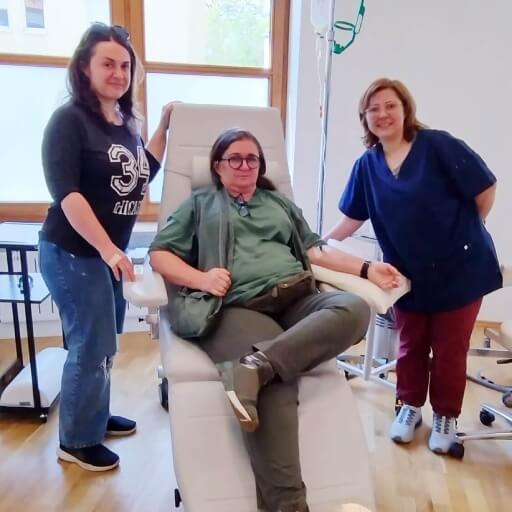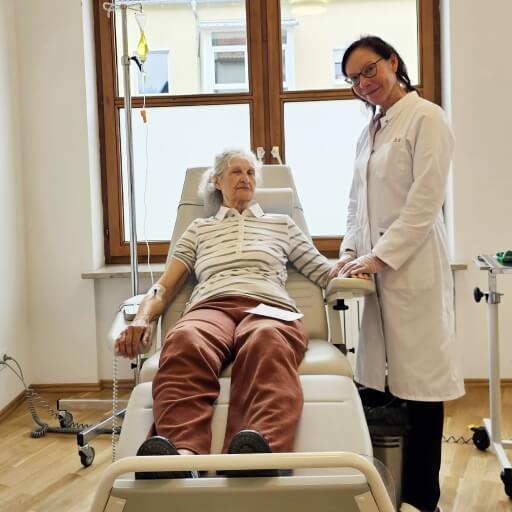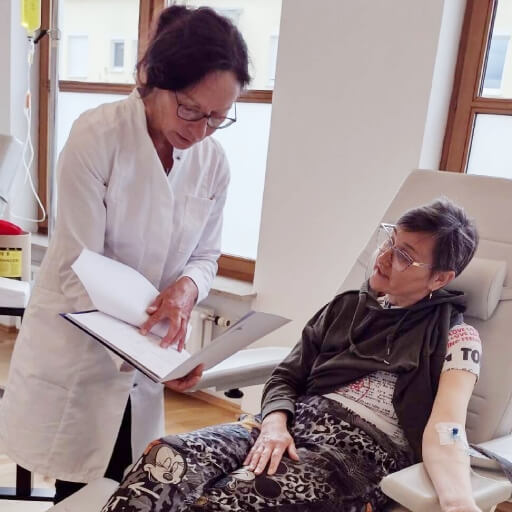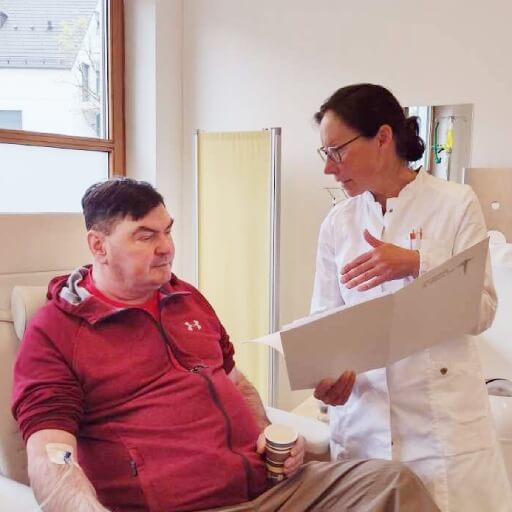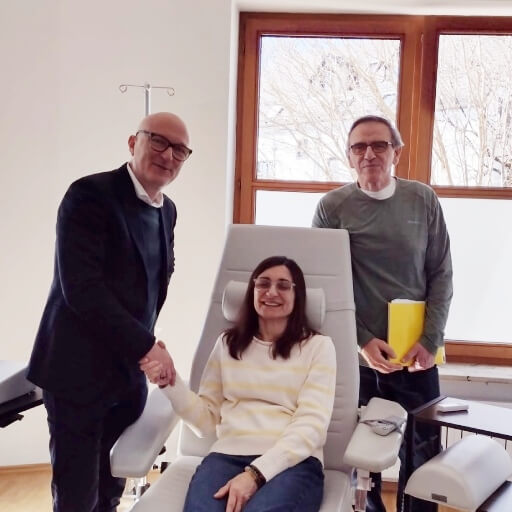Благодаря интервенционной радиологии лечение рака сейчас кардинально изменилось – теперь у врачей появилась возможность обеспечивать пациентам прекрасные результаты лечения с минимальными сроками восстановления после терапии. В отличие от традиционного хирургического лечения процедуры интервенционной радиологии позволяют прицельно воздействовать на опухоль без повреждения соседних здоровых тканей. При этом такая терапия практически не вызывает болевых ощущений, имеет меньший профиль осложнений и дает возможность онкобольному быстро восстановиться. В настоящее время даже у пациентов с прогрессирующим заболеванием есть возможность получить эффективное лечение благодаря процедуре эмболизации при раке, при которой непосредственно к опухолевому очагу доставляется в 15 раз более высокая доза химиопрепаратов по сравнению с системным введением лекарственных средств. В этой статье мы расскажем о то, как инновационные малоинвазивные методы лечения дают новую надежду пациентам даже в тех случаях, которые не так давно считались безнадежными. При этом проведение такого новаторского лечения занимает считанные минуты.
Методы абляции
Абляция представляет собой высокоэффективный метод уничтожения злокачественной опухоли посредством воздействия на нее экстремально низкими или высокими температурами. Эти малоинвазивные процедуры предназначены для лечения новообразований размером до 2 см и проводятся амбулаторно, благодаря чему являются привлекательным вариантом для пациентов, желающих получить эффективное лечение с минимальными изменениями в своей привычной повседневной жизни.
Радиочастотная абляция (РЧА)
Радиочастотная абляция – это метод лечения, предполагающий применение высокоэнергетических радиоволн для высокоточного уничтожения раковых клеток малоинвазивным доступом. Во время проведения этой амбулаторной процедуры врачи используют специальный тонкий зонд, по форме напоминающий иглу, который вводится непосредственно в опухоль под контролем УЗИ или КТ. Через этот зонд к онкологическому очагу подается высокочастотный электрический ток, генерирующий тепловую энергию за счет сопротивляемости тканей, которая с высокой эффективностью уничтожает раковые клетки при сохранение целостности окружающих здоровых тканей.
В современных устройствах для проведения РЧА используются усовершенствованные конструкции электродов, способствующие лучшему распределению тепловой энергии на поверхности раковых клеток. К тому же усовершенствованные механизмы контроля мощности тепловой энергии в этих устройствах помогают преодолевать определенные физические ограничения (например, обугливание тканей и изменения импеданса), возникающие в процессе лечения.
Основные преимущества РЧА:
- Амбулаторная процедура с более коротким сроком восстановления по сравнению с традиционным хирургическим вмешательством
- Отличается особой эффективностью при опухолях печени, почек и легких размером менее 2 см
- Малоинвазивный метод лечения с превосходным профилем безопасности
Микроволновая абляция (МВА)
Микроволновая абляция – это новаторская разработка в сфере технологий термической абляции, обладающая рядом преимуществ по сравнению с традиционными методами лечения. При проведении МВА вместо электрического тока применяется энергия электромагнитного поля, вызывающая быстрые темпы колебания молекул воды в тканях, в результате чего генерируется тепловая энергия. За счет этого принципиального отличия МВА способна более эффективно уничтожать опухолевые ткани в сложных клинических случаях, при которых РЧА не обладает достаточной эффективностью, в том числе при поражениях костных тканей и тканей, ранее подвергавшихся воздействию абляции.
МВА позволяет формировать более крупные и равномерные зоны абляции, а также метод менее восприимчив к эффекту «теплоотвода» от близлежащих кровеносных сосудов. Современные устройства для проведения МВА работают на частоте 915 МГц или 2,45 ГГц. В них встроены усовершенствованные механизмы охлаждения вала, предотвращающие ожоги кожи и непреднамеренное повреждение тканей. Сейчас появляется все больше клинических данных, подтверждающих эффективность МВА, но врачи пока выполняют эту процедуру с максимальной осторожностью и осуществляют тщательный мониторинг на каждом ее этапе с целью исключения осложнений.
Акваабляция
Акваабляция – это инновационный вид терапии, при котором уничтожение патологической ткани осуществляется не за счет ее нагрева до экстремально высоких температур, а с помощью воздействия на нее высокоскоростной водяной струей, генерируемой специальной роботизированной системой. Акваабляция пока не относится к числу стандартных методов лечения рака, но процедура обладает высокой точностью, благодаря чему расценивается в качестве перспективного терапевтического подхода в области онкологии.
Согласно последним сравнительным исследованиям, акваабляция имеет преимущества над традиционными методами лечения, например, трансуретральной резекцией простаты (ТУРП). Клинические преимущества процедуры:
- Более низкий профиль побочных эффектов по сравнению с традиционными методиками
- Исключительная точность лечебной манипуляции благодаря ее выполнению под контролем роботизированной системы и визуализации в режиме реального времени
- Более быстрое восстановление пациента и снижение количества осложнений после процедуры
- Исключение повреждений жизненно важных анатомических структур
Криоабляция
Криоабляция при раке предполагает таргетное воздействие на раковые клетки экстремально низкими температурами. Данный метод обладает особыми преимуществами в борьбе с определенными видами опухолей. В ходе проведения криоабляции используются тонкие металлические зонды, с помощью которых внутри опухоли формируются ледяные шары. За счет быстрого расширения газа в наконечнике зонда их температура может достигать до -140°C. В отличие от методов термической абляции, при криоаблации формируются визуально видимые зоны воздействия, которые врач может отслеживать в режиме реального времени с помощью различных методов визуализации, обеспечивая таким образом исключительную точность лечебных манипуляций вблизи чувствительных анатомических структур.
Криоабляция отличается особой эффективностью при лечении рака почек и метастазов в костях, но сейчас эта методика также все чаще используется для борьбы с опухолями легких, простаты и молочной железы. При проведении криоабляции отмечается более быстрое и полное восстановление тканей в патологической области по сравнению с лечением техниками термоабляции. Тем не менее, стоит помнить, что в ходе выполнения криоабляции существует риск развития осложнений, например, кровотечений (из-за отсутствия эффекта коагуляции крови). В некоторых случаях криоабляция проводится под общей анестезией, но при этом по сравнению с другими техниками абляции она позволяет эффективно уничтожать более крупные опухоли. Следовательно, метод расценивается в качестве важного инструмента в арсенале команды онкологов со специализацией в области интервенционной радиологии.
Результаты лечения рака простаты методом криоабляции
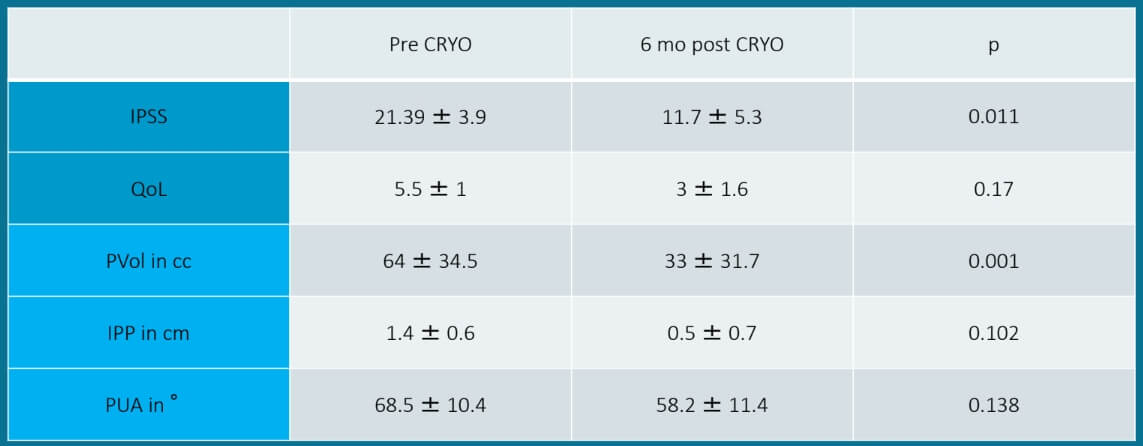
Необратимая электропорация (IRE)
Необратимая электропорация (система NanoKnife) является уникальным методом лечения рака, действие которого не основано на воздействии на опухолевую ткань холодом или теплом. Напротив, техника IRE предполагает генерацию коротких, мощных электрических импульсов, которые доставляются к новообразованию через специальные игольчатые электроды для повреждения мембран раковых клеток, что в результате приводит к их гибели. В отличие от термических техник абляции процедура IRE имеет высокий профиль безопасности, что позволяет применять ее при лечении опухолей вблизи жизненно важных анатомических структур, например, кровеносных сосудов и желчных протоков. Следовательно, необратимая электропорация считается особо важным методом лечения неоперабельных опухолей и новообразований с труднодоступной локализации, при которых слишком рискованно применять традиционные виды терапии.
Ключевые особенности метода IRE:
- Нетермическая процедура, исключающая травматизацию жизненно важных анатомических структур, например, кровеносных сосудов и желчных протоков
- Обеспечивает формирование четких границ между здоровыми тканями и тканями, подвергшимися воздействию абляции
- Обеспечивает минимальное образование рубцовой ткани, так как основная структура ткани остается неповрежденной
- Исключается восприимчивость к эффекту «теплоотвода» от близлежащих кровеносных сосудов, которая связана с определенными ограничениями при проведении других видов абляции
- Относительно краткосрочные сеансы лечения, обычно длящиеся всего несколько минут
- Обеспечивает особенно многообещающие результаты при лечении опухолей с локализацией вблизи жизненно важных анатомических структур
- Выступает в качестве оптимального варианта лечения для пациентов с ограниченными возможностями терапии из-за локализации злокачественного новообразования
- Для установки электродов выполняются небольшие разрезы
Необратимая электропорация выполняется под общей анестезией с применением миорелаксантов для предотвращения непроизвольных сокращений мышц во время процедуры. Клинические исследования продемонстрировали обнадеживающие результаты при лечении определенных видов рака техникой IRE, но научная работа в этой области продолжается – специалисты ставят перед собой задачу достоверно определить эффективность этого метода лечения при различных видах рака. В настоящее время наиболее широкое признание получило лечение рака простаты NanoKnife (IRE). Для пациентов с раком предстательной железы этот метод является альтернативой традиционной брахитерапии при раке простаты, предполагающей имплантацию радиоактивных семян непосредственно в предстательную железу для таргетного облучения опухоли при минимальном поражении здоровых окружающих тканей.
Профессор Штелинг о преимуществах необратимой электропорации над традиционными методами лечения
Трансартериальная химиоэмболизация (TACE)
Трансартериальная химиоэмболизация (TACE) – это один из наиболее прогрессивных малоинвазивных методов лечения рака, сочетающий таргетную доставку химиопрепаратов непосредственно к онкологическому очагу с одномоментной блокировкой кровоснабжающих опухоль сосудов. Для пациентов с некоторыми видами рака этот вид терапии двойного действия является эффективным вариантом лечения, обеспечивающий максимальный терапевтический эффект при минимизации системных побочных эффектов.
Основные принципы проведения процедуры
Принцип действия TACE основан на взаимодополняющих механизмах, одномоментно воздействующих на злокачественную опухоль:
- Таргетная доставка химиопрепаратов непосредственно к онкологическому очагу. Высококонцентрированные дозы химиопрепаратов доставляются непосредственно к опухоли через систему ее кровоснабжения, что позволяет воздействовать на нее в 15 раз более высокой дозой лекарственных средств по сравнению с классической системной химиотерапией.
- Эмболизация. Сразу же после доставки лекарственных препаратов к онкологическому очагу в просвет кровоснабжающих опухоль сосудов вводятся крошечные эмболизирующие частицы, блокирующие приток крови к новообразованию, в результате чего оно лишается кислорода и питательных веществ. При этом химиопрепараты продолжают локализовано воздействовать на опухоль.
- Высокоточное лечение. Благодаря прогрессивным техникам визуализации врачи достоверно определяют кровеносные сосуды, питающие опухоль, и проводят необходимые лечебные манипуляции без вреда для здоровых тканей.
Вариации процедуры
В настоящее время существует несколько техник проведения TACE:
- Традиционная трансартериальная химиоэмболизация (cTACE). При традиционном варианте процедуры к онкологическому очагу доставляется смесь химиопрепаратов с йодированным маслом, после чего в просвет питающих опухоль сосудов вводятся эмболизирующие агенты. Масло визуализируется на снимках, выступая в качестве носителя лекарственных препаратов и эмболизирующего материла.
- Трансартериальная химиоэмболизация с использованием микросфер, высвобождающих лекарственные препараты (DEB-TACE). При проведении этой новаторской процедуры TACE применяются специально разработанные микросферы, которые одновременно блокируют приток крови к опухоли и медленно высвобождают химиопрепараты, обеспечивая более контролируемую и длительную доставку лекарственных средств с потенциально меньшим количеством побочных эффектов.
- Индивидуальный подбор эмболизирующих агентов и химиопрепаратов. В зависимости от специфики диагностированного у онкобольного вида рака и особенностей пациента врачи в индивидуальном порядке подбирают для него оптимальные эмболизирующие материалы (желатиновую губку, частицы поливинилового спирта, микросферы) и химиопрепараты.
Области клинического применения
TACE продемонстрировала особую эффективность при лечении нескольких видов рака:
- Первичный рак печени (гепатоцеллюлярная карцинома). TACE выступает в качестве метода лечения первой линии для пациентов, которые не являются кандидатами на хирургическое вмешательство, или промежуточного лечебного мероприятия в рамках подготовки к трансплантации печени.
- Метастазы в печени. Метод отличается особой эффективностью при распространении метастазов в печень на фоне колоректального рака, рака молочной железы и нейроэндокринных опухолей.
- Рак поджелудочной железы. Процедура TACE обладает высокой эффективностью при лечении метастазов в печень при раке поджелудочной железы, причем исследования показали, что включение трансартериальной химиоэмболизации в схему мультимодальной терапии в 70% позволяет добиться контроля над заболеванием.
- Рак легкого. Расценивается в качестве важного варианта лечения при первичном раке легкого и метастазах в легкие, которые не поддаются хирургическому лечению и проявляют резистентность к стандартным видам терапии.
Как правило, продолжительность процедуры TACE составляет 1-2 часа. Она проводится под местной анестезией с легкой седацией. Через бедренную артерию в паху вводится катетер, который под визуальным контролем доставляется к сосудам, обеспечивающим кровоснабжение опухоли. Большинство пациентов возвращаются домой через 24-48 часов после проведения лечебной манипуляции. У более 85% пациентов после TACE практически не наблюдается побочных эффектов.
Профессор Томас Фогль о таргетном лечении рака методом TACE
Профессор Фогль является одним из ведущих европейских специалистов по проведению лечения методом TACE – доктор ежедневно успешно выполняет 8-10 процедур регионарной химиотерапии. По мнению профессора Фогля, метод TACE имеет три ключевых преимущества: высокоточная доставка химиопрепаратов непосредственно к опухоли, возможность воздействия на онкологический очаг в 15 раз более высокой дозой лекарственных препаратов по сравнению с системной химиотерапией и лишение новообразования кровоснабжения за счет введения эмболизирующего материала в просвет питающих его сосудов. За плечами специалиста имеется богатый клинический опыт, который демонстрирует, что процедура TACE способна помочь эффективно контролировать рост опухоли и значительно улучшить качество жизни пациента при включении ее в комплексную схему лечения рака.
Электрохимиотерапия
Электрохимиотерапия (ECT) представляет собой инновационный метод лечения рака, сочетающий проведение традиционной химиотерапии с локальным воздействием на опухоль электрическими импульсами. Такой подход способствует существенному повышению эффективности лекарственных средств. При воздействии на онкологический очаг электрическими импульсами временно повышается проницаемость клеточных мембран (электропорация), благодаря чему обеспечивается лучшее проникновение химиопрепаратов в раковые клетки в гораздо более высоких концентрациях, часто при использовании меньших доз лекарственных средств.
Электрохимиотерапия продемонстрировала особенно многообещающие результаты при лечении нескольких видов рака: изначально метод применялся лишь для лечения метастазов на фоне меланомы, а теперь он также успешно используется для терапии злокачественных опухолей головы и шеи. Кроме того, электрохимиотерапия обеспечивает хорошие результаты при лечении пациенток с кожными метастазами на фоне рака молочной железы и резистентными к медикаментозной терапии формами рака молочной железы. Согласно данным текущих исследований, электрохимиотерапия продемонстрировала эффективный результат в борьбе с гинекологическим раком, колоректальным раком и раком поджелудочной железы. Следует отметить, что при раке поджелудочной железы эта методика позволяет добиться существенного улучшения показателей выживаемости по сравнению с лечением по стандартному протоколу.
Преимущества электрохимиотерапии:
- Способна преодолеть многочисленные механизмы резистентности к медикаментозной терапии, ограничивающие эффективность традиционной химиотерапии
- Требует применения меньших доз лекарственных препаратов, что способствует снижению количества системных побочных эффектов
- Обеспечивает таргетное воздействие на определенные участки опухоли
- Наряду с непосредственным уничтожением опухоли стимулирует формирование иммунного ответа против раковых клеток
- Улучшает локальный контроль над опухолью более чем в 70% случаев
- Проводится амбулаторно и предполагает минимальные сроки восстановления после лечения
Обеспечение локального контроля над опухолью с помощью различных техник абляции

Выбор оптимального метода лечения в соответствии с индивидуальными потребностями пациента
При выборе наиболее подходящего метода лечения рака учитывается конкретный диагноз, особенности выявленной у пациента опухоли и состояние здоровья онкобольного. Каждый метод интервенционной радиологии имеет свои уникальные преимущества, поэтому для достижения оптимальных результатов лечения врачи оценивают клиническую ситуацию каждого пациента в индивидуальном порядке.
| Метод лечения | Оптимальный вариант при | Преимущества | Ограничения | Стоимость |
|---|---|---|---|---|
| Традиционное хирургическое вмешательство | Опухолях, подлежащих хирургическому удалению, с четкими границами | При успешном результате операция обеспечивает полное удаление опухоли | Инвазивный метод лечения с повышенным риском развития осложнений; в некоторых случаях проведение операции невозможно из-за локализации опухоли | €25 000 - €45 000 |
| Классическая химиотерапия | Системном заболевании с множественными онкологическими очагами | Помогает подавить прогрессирование онкопроцесса на поздних стадиях, воздействует на микроскопические раковые клетки | Вызывает серьезные побочные эффекты, опухоль может быть резистентной к лекарственным препаратам | €80 000 - €150 000 за полный курс |
| Лучевая терапия | Локализованных опухолях в качестве адъювантного лечения | Неинвазивный метод лечения, отличающийся высокой точностью | Провоцирует повреждение окружающих тканей, присутствуют ограничения по применяемой дозе облучения | €28 000 - €42 000 |
| Радиочастотная абляция (РЧА) | Опухолях печени, почек и легких размером менее 2 см | Амбулаторная процедура с минимальными сроками восстановления и превосходным профилем безопасности | Менее эффективна при опухолях крупных размеров | €6 500 - €24 000 за сеанс |
| Микроволновая абляция (МВА) | Сложных опухолях, например, с локализацией в костях или тканях, ранее подвергавшихся воздействию абляции | Способна формировать более крупные и равномерные зоны абляции; в меньшей степени подвержена эффекту «теплоотвода» | При проведении такого лечения требуется тщательный мониторинг для предотвращения осложнений | €6 500 - €24 000 за сеанс |
| Криоабляция | Раке почек, метастазах в костях, опухолях легких и молочной железы | Способна формировать визуально видимые зоны воздействия, которые врач может отслеживать в режиме реального времени; обеспечивает более быстрое и полное восстановление тканей в патологической области по сравнению с лечением техниками термической абляции | В некоторых случаях для проведения данной лечебной процедуры может потребоваться применение общей анестезии | €6 500 - €24 000 за сеанс |
| Необратимая электропорация (IRE) | Опухолях вблизи жизненно важных анатомических структур, например, кровеносных сосудов и желчных протоков – такие случаи считаются неоперабельными | Нетермический метод, исключающий повреждение жизненно важных анатомических структур; минимальное образование рубцовой ткани, так как основная структура ткани остается неповрежденной | При проведении данной процедуры применяется общая анестезия и миорелаксанты | €35 300 - €38 900 |
| TACE | Первичном раке печени, метастазах в печень на фоне колоректального рака, рака молочной железы и нейроэндокринных опухолей | Обеспечивает в 15 раз более высокую концентрацию лекарственных средств в онкологическом очаге по сравнению с системной химиотерапией и одномоментно блокирует приток крови к опухоли | Лечение этим методом предполагает госпитализацию пациента на 1-2 дня | €6 500 - €24 000 за сеанс |
| Электрохимиотерапия (ЭХТ) | Метастазах меланомы, злокачественных опухолях головы и шеи, раке молочной железы с кожными метастазами | Способна преодолеть многочисленные механизмы резистентности к медикаментозной терапии; предполагает применение низких доз химиопрепаратов; стимулирует иммунный ответ против раковых клеток | Применение этого метода лечения возможно лишь при выявлении у пациента опухоли с доступной локализацией | €10 000 - €18 000 |
Данные Booking Health. В таблице указана приблизительная стоимость лечения стандартными и инновационными методиками. Цены могут значительно отличаться в зависимости от клиники и страны, в которых будет проходить лечение, сложности клинического случая и количества сеансов терапии.
Вдохновляющие истории наших пациентов об успешном лечении рака
После нескольких неудачных попыток лечения рака в Румынии и резкого ухудшения состояния здоровья Николай был в отчаянии и потерял всякую надежду. Тем не менее, его сын Богдан не собирался сидеть сложа руки. Он оставил заявку на лечение на сайте Booking Health, и уже через 12 часов с ним связались специалисты компании. Богдан отправил им медицинские заключения и снимки отца, после ознакомления с которыми эксперты Booking Health приступили к организации его лечения в Германии. Уже через несколько дней Николай отправился во Франкфурт, где ему предстояло пройти терапию у известного европейского радиолога профессора Томаса Фогля.
«Я был в поиске неотложного лечения рака для своего отца, так как после нескольких неудачных попыток терапии в Румынии его состояние сильно ухудшилось», – вспоминает Богдан. «Уже через 2 дня после первого телефонного разговора с менеджерами компании Booking Health мы забронировали авиабилеты во Франкфурт. Лечением моего папы занимался один из лучших радиологов Европы».
Больше всего семью Николая поразила безупречная координация лечения. По его прибытию в клинику команда врачей уже досконально изучила его медицинские документы и была готова сразу же приступить к лечению без проведения ненужной повторной диагностики.
«После проведения всего двух процедур химиоэмболизации мой отец чувствует себя гораздо лучше», – говорит Богдан. «Специалисты Booking Health продемонстрировали исключительный профессионализм и помогли нам предельно быстро организовать прием на лечение к профессору Фоглю».
Сейчас Николай продолжает получать лечение, но это стало возможным лишь благодаря превосходному медицинскому обслуживанию в клинике и оперативной организации поездки на лечение в Германию.
Инновации в онкологии: опыт пациентов Booking Health
Передовое лечение рака, которое дарит надежду
При выявлении рака на поздних стадиях онкобольным часто говорят об ограниченных возможностях традиционного лечения. Но не все так безнадежно, ведь с внедрением в клиническую практику новаторских техник интервенционной онкологии у пациентов появились альтернативные варианты лечения, которые способны обеспечить хороший результат даже на поздних стадиях заболевания. Специализированные центры по всему миру практикуют инновационные виды терапии, которые на сегодняшний день пока могут быть недоступны в родной стране пациента.
Лечение за рубежом имеет ряд преимуществ: пациент получает доступ к передовым технологиям, услугам специалистов с обширным клиническим опытом и малоинвазивным методам лечения, способным помочь и при этом сохранить онкобольному достойное качество жизни. К тому же в некоторых случаях такая терапия может обойтись пациенту дешевле, чем в родной стране.
Проведение таких инновационных терапевтических процедур, как TACE, абляция и IRE, помогло многим пациентам с раком 4 стадии добиться значительного улучшения состояния здоровья. Разумеется, что обеспечить полное излечение рака на последней стадии практически невозможно, но все же такие вмешательства помогают добиться эффективного контроля над прогрессированием заболевания, улучшить показатели выживаемости и обеспечить онкобольному достойное качество жизни.
Главное – не опускать руки и не терять надежды, ведь предлагаемые за рубежом возможности лечения действительно способны помочь и спасти жизнь пациенту с поздней стадией рака.
Поездка на лечение за границу с Booking Health
Самостоятельный поиск наилучшей тактики лечения с учетом вашей индивидуальной клинической ситуации – довольно сложная задача. Испытав на себе многочисленные курсы лечения, проконсультировавшись со множеством специалистов и испробовав различные терапевтические процедуры, вам может быть трудно сориентироваться во всей предоставленной врачами информации. В таком случае пациенты зачастую выбирают первый же предложенный вариант лечения или соглашаются на лечение с применением стандартизированных терапевтических протоколов, которое повлечет за собой множество побочных эффектов, вместо того, чтобы рассмотреть возможность терапии с помощью инновационных процедур.
Если вы хотите сделать осознанный выбор и получить лечение рака в соответствии с индивидуально разработанной для вас схемой с учетом особенностей вашей конкретной клинической ситуации, проконсультируйтесь с врачами-консультантами Booking Health. Компания Booking Health уже более 12 лет занимает ведущие позиции в сфере организации лечения за рубежом с применением новейших инноваций в медицине, поэтому ее специалисты обладают огромным опытом в составлении персонализированных комплексных программ лечения для каждого пациента. Booking Health пользуется репутацией авторитетной компании, которая предоставляет персонализированный подбор схемы лечения рака 4 стадии и клиники с прямым бронированием приема в медицинском центре, а также полную поддержку на каждом этапе лечения – от решения организационных вопросов до помощи в процессе лечения. Мы предлагаем:
- Оценку и анализ выписок пациента
- Составление индивидуальной программы лечения
- Подбор подходящего медицинского учреждения для лечения
- Подготовку медицинской документации и ее направление в выбранную пациентом для лечения клинику
- Консультации с врачами клиники в Германии для разработки оптимальной медицинской программы на этапе подготовки к поездке на лечение
- Экспертные консультации во время пребывания в больнице
- Последующее консультирование пациента после его возвращения на родину по завершению медицинской программы
- Решение организационных вопросов в рамках подготовки к поездке на лечение за границу
- Координацию пребывания пациента в другой стране, помощь в бронировании номера в отеле или апартаментов на период лечения
- Помощь в оформлении визы и бронировании авиабилетов
- Услуги переводчика и персонального координатора, который будет с вами на связи 24/7
- Прозрачные цены на лечение, без скрытых платежей
Здоровье – главная ценность в жизни каждого человека, доверять заботу о которой стоит лишь лучшим специалистам с богатым опытом и проверенной репутацией. Booking Health – это ваш надежный партнер, который оказывает всестороннюю помощь на пути к восстановлению здоровья и улучшению качества жизни. Свяжитесь с врачом-консультантом компании, чтобы узнать больше о возможностях персонализированного лечения метастатического рака ведущими экспертами с использованием инновационных методов.
Частые вопросы наших пациентов
Отправить запрос на лечениеИнтервенционная радиология для рака предполагает проведение минимально инвазивных процедур под визуальным контролем для диагностики и лечения опухолей. Сюда также относятся высокоточные техники биопсии. В отличие от традиционных хирургических вмешательств, для обеспечения доступа к опухоли врачи выполняют миниатюрные разрезы, благодаря чему такое лечение рака отличается высокой точностью и малой травматичностью.
Врач-интервенционист под контролем передовых методов визуализации (УЗИ, КТ или МРТ) выполняет миниатюрные разрезы, через которые к опухолевому очагу доставляются специальные инструменты для выполнения необходимых терапевтических манипуляций. Процедуры интервенционной радиологии относятся к числу таргетных методов лечения рака с минимальной степенью повреждения окружающих здоровых тканей.
Интервенционная радиология и рак – тесно взаимосвязанные понятия. Эти эффективные лечебные процедуры проводятся при борьбе с опухолями печени, почек, легких, простаты, костей и молочной железы.
Да, абляция помогает эффективно уничтожать злокачественные опухоли размером до 2 см с помощью тепловой энергии (радиочастотная/микроволновая абляция), холода (криоабляция) или электрических импульсов (IRE). Исследования показывают высокие показатели успешности лечения этим методом у пациентов с опухолями печени, почек и легких. По сравнению с традиционными нехирургическими вариантами лечения рака интервенционная терапия является малоинвазивным методом с довольно короткими сроками восстановления.
При абляции опухоль уничтожают, воздействуя на нее экстремально высокими или низкими температурами или электрическими импульсами. При эмболизации терапевтический эффект достигается за счет окклюзии кровеносных сосудов, питающих опухоль, в результате чего она лишается кислорода и питательных веществ. Техника TACE предполагает таргетное введение химиопрепаратов в онкологический очаг через сосудистое русло перед блокировкой притока крови к новообразованию эмболизирующим материалом.
Являются ли методы интервенционной радиологии безопасным нехирургическим альтернативным вариантом терапии?
Да, методы интервенционной радиологии представляют собой безопасный нехирургический альтернативный вариант терапии. По сравнению с классической операцией они обеспечивают более низкий уровень осложнений и риск заражения инфекцией, а также минимальные кровопотери. Многие пациенты с противопоказаниями к операции являются кандидатами на такое нехирургическое лечение рака.
К ним относятся менее выраженный болевой синдром, более быстрое восстановление после проведения лечения, более короткие сроки госпитализации, минимальное количество шрамов, более низкий уровень осложнений и возможность сохранения нормальной функции органов. Многие из интервенционных процедур проводятся амбулаторно, благодаря чему у пациентов есть возможность предельно быстро вернуться к привычной повседневной жизни.
Да, они отличаются высокой эффективностью в устранении болевого синдрома при раке и часто проводятся в паллиативных целях. Такие процедуры, как блокада нервов, вертебропластика при опухолях позвоночника и абляция, способствуют существенному облегчению боли в тех случаях, когда из-за роста опухоли у пациента развивается компрессия нервов или ослабление плотности костной ткани. В таких ситуациях проведение интервенционных вмешательств часто помогает пациенту избежать регулярного приема обезболивающих препаратов.
Трансартериальная химиоэмболизация (TACE) в основном применяется при раке легких и печени, в том числе при терапии гепатоцеллюлярной карциномы и метастазов на фоне колоректального рака, рака молочной железы, рака поджелудочной железы и нейроэндокринных опухолей. При некоторых стадиях заболевания эффективность данной процедуры достигает 70%.
Суть эмболизации заключается в блокировке притока крови к опухоли посредством введения в питающие ее сосуды специальных микрочастиц. В результате проведения этой процедуры опухоль лишается кислорода и питательных веществ, что приводит к уменьшению ее размеров. При выполнении эмболизации в сочетании с химиотерапией (TACE) обеспечивается таргетное воздействие на опухоль высокой дозой лекарственных препаратов.
Восстановление происходит довольно быстро: большинство пациентов проводят в стационаре всего 1-2 дня, при этом у более 85% онкобольных наблюдаются лишь слабо выраженные побочные эффекты. В отличие от традиционного хирургического лечения, после которого человеку на восстановление потребуется несколько недель, при выборе в пользу программ интервенционной радиологии многие пациенты могут вернуться к нормальному ритму жизни уже через несколько дней после проведения терапии.
При проведении TACE через бедренную артерию вводится катетер, который под визуальным контролем доставляется к сосудам, питающим опухоль. При такой таргетной доставке химиопрепаратов у врачей есть возможность применять в 15 раз более высокие дозы лекарственных средств, чем при системной химиотерапии.
Выбирайте лечение за рубежом и Вы, несомненно, получите отличный результат!
Авторы:
Статья составлена под редакцией экспертов в области медицины, врачей-специалистов доктора Надежды Иванисовой и доктора Вадима Жилюка. Для лечения состояний, о которых идет речь в статье, необходимо обратиться к врачу; информация в статье не предназначена для самолечения!
С редакционной политикой, которая отражает наше стремление к точности и прозрачности, можно ознакомиться здесь. Перейдите по ссылке, чтобы ознакомиться с нашими правилами.
Источники:
Читайте:
Лечение рака на поздних стадиях: новейшие методы и технологии в борьбе с метастазами
Комплексная иммунотерапия рака в ведущих клиниках Германии
Комплексная иммунотерапия рака дендритными клетками в Германии
Меню статьи:
- Методы абляции
- Необратимая электропорация (IRE)
- Трансартериальная химиоэмболизация (TACE)
- Электрохимиотерапия
- Выбор оптимального метода лечения в соответствии с индивидуальными потребностями пациента
- Вдохновляющие истории наших пациентов об успешном лечении рака
- Передовое лечение рака, которое дарит надежду
- Поездка на лечение за границу с Booking Health
- Частые вопросы наших пациентов
Не знаете, с чего начать?
Свяжитесь с Booking Health
